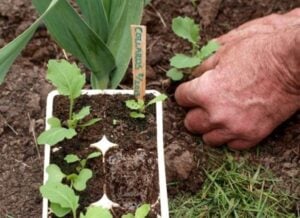How to Transplant Seedlings of the Brassica (Cabbage) Family

The month of April brings warmer spring weather to most regions, meaning that it’s time to transplant. If you’ve started seeds indoors, some of them will be yearning for the real ground. The brassica family members, which includes collards, cabbage, broccoli, kale, kohlrabi, cauliflower, andBrussels sprouts, are ready to be transplanted in regions where the last frost date has passed, as are chard, lettuce and spinach. An exciting step towards creating your lush and colorful summer garden, transplanting signifies the turning point in a vegetable gardener’s season.
The first step is to move flats or pots of your seedlings to an outdoor space where they can get used to natural daylight and temperature fluctuations between day and night. This is called ‘hardening off’, and prevents the plant from going into total shock once it is put into the ground, which will be considerably colder than its little pot. If the plants have grown significantly, they can be up-potted into 4-inch pots, but don’t bother if you plan on transplanting within days.
Make sure the soil you are planting in has been adequately limed, as brassicas don’t do well in acidic soil. Augmenting your row or bed with a thin layer of compost will help your transplants get well established, as the extra nutrition will help them send down strong roots. Do not plant brassicas in the same bed two years in a row, as this will likely encourage pests and diseases.

Brassica seedlings should generally be between 3 and 6 inches tall when transplanting them, or at least have established their second set of leaves. The first set are heart-shaped, where as the second set take on the shape of a mature plant leaf. Plant spacing will vary according to the type of brassica you are transplanting, so make sure you leave at least a foot in between for larger plants such as kale and sprouting broccoli, whereas small cabbages or dwarf kales only need about 6 inches in between each other. Place your pots out or make holes in the soil to get your spacing right before you start putting plants in the ground. If planting in beds or wide rows, an off-set pattern will be the most efficient and aesthetically pleasing. Narrower rows can be planted single-file.

Loosen the soil around the roots gently by slightly pressing all sides of the pot or starter pack, and carefully tip the plant out, disturbing its roots as little as possible. Get the plant slightly deeper into the ground than it was in the pot, only needing to leave about ½ and inch of stem showing above ground. Don’t press too hard when you fill in the space around the transplant as it may compact the soil. Just give it a gentle pat to settle the soil around the fragile roots.

Brassicas take well to companion planting, so placing them in between plants that will have long, thin stalks, such as elephant garlic or onions, will still give them ample growing space and sunlight. Interplanting lettuces and spinach is a great way to maximize growing space, as these can be planted fairly densely in between broccoli plants, and will actually enjoy the shade on sunnier days. Brassicas also benefit from growing near chamomile, dill, mint, rosemary, and sage, but avoid placing them right by tomatoes, peppers or eggplant.
Images: Myrtle Glen Farm, graibeard

